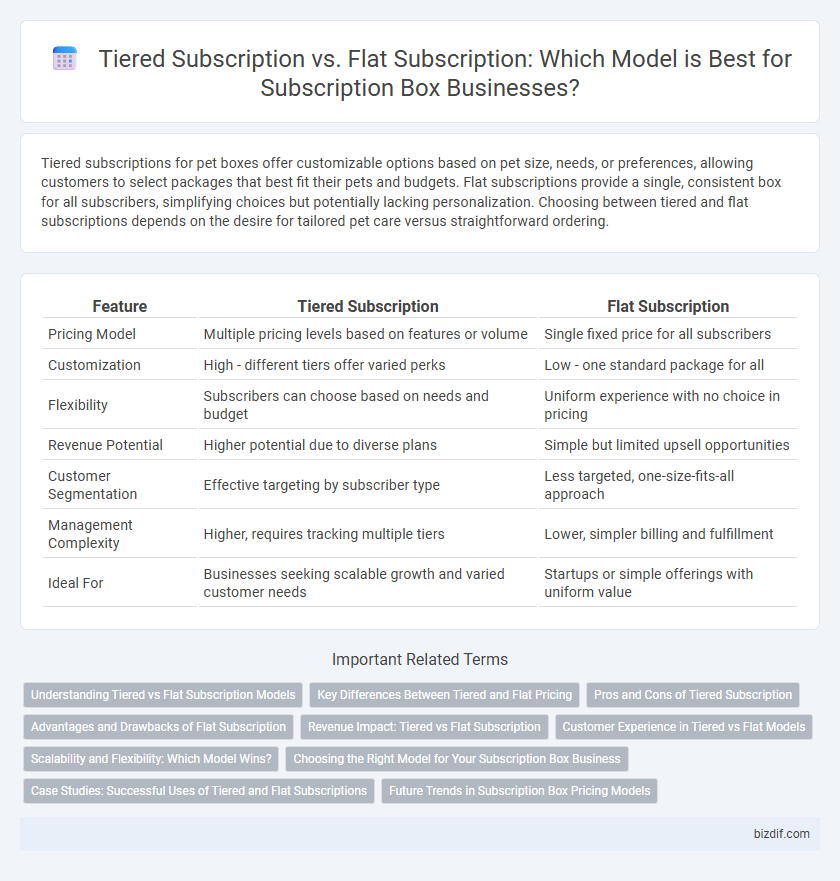Tiered subscriptions for pet boxes offer customizable options based on pet size, needs, or preferences, allowing customers to select packages that best fit their pets and budgets. Flat subscriptions provide a single, consistent box for all subscribers, simplifying choices but potentially lacking personalization. Choosing between tiered and flat subscriptions depends on the desire for tailored pet care versus straightforward ordering.
Table of Comparison
| Feature | Tiered Subscription | Flat Subscription |
|---|---|---|
| Pricing Model | Multiple pricing levels based on features or volume | Single fixed price for all subscribers |
| Customization | High - different tiers offer varied perks | Low - one standard package for all |
| Flexibility | Subscribers can choose based on needs and budget | Uniform experience with no choice in pricing |
| Revenue Potential | Higher potential due to diverse plans | Simple but limited upsell opportunities |
| Customer Segmentation | Effective targeting by subscriber type | Less targeted, one-size-fits-all approach |
| Management Complexity | Higher, requires tracking multiple tiers | Lower, simpler billing and fulfillment |
| Ideal For | Businesses seeking scalable growth and varied customer needs | Startups or simple offerings with uniform value |
Understanding Tiered vs Flat Subscription Models
Tiered subscription models offer multiple pricing levels based on the range of products or services provided, allowing customers to select a plan that fits their specific needs and budget. Flat subscription models charge a single price regardless of usage or product variety, simplifying billing but limiting customization. Understanding the key differences helps businesses optimize revenue and enhances customer satisfaction by aligning offerings with consumption patterns.
Key Differences Between Tiered and Flat Pricing
Tiered subscription pricing offers multiple levels with varying features or product quantities, allowing customers to choose based on their needs and budget. Flat subscription pricing charges a single fixed price for all subscribers, regardless of usage or content volume. Key differences include flexibility and customization in tiered pricing versus simplicity and predictability in flat pricing models.
Pros and Cons of Tiered Subscription
Tiered subscription models offer customers multiple pricing levels based on features or product quantities, increasing flexibility and appealing to a broader audience. Pros include higher revenue potential through customized options and improved customer satisfaction by catering to diverse needs. Cons involve increased complexity in management and possible customer confusion due to the variety of choices.
Advantages and Drawbacks of Flat Subscription
Flat subscription offers predictable monthly costs and simplicity, making it easy for customers to understand and manage their spending. However, it may lack flexibility for users with varying needs and could lead to perceived lower value if the box contents do not match individual preferences. This model can limit customization options and potentially reduce customer satisfaction compared to tiered subscription plans.
Revenue Impact: Tiered vs Flat Subscription
Tiered subscription models generate higher revenue by catering to diverse customer needs with multiple pricing options, encouraging upgrades and increased customer lifetime value. Flat subscription models offer simplicity and predictable income but often limit revenue potential due to uniform pricing across all users. Businesses leveraging tiered subscriptions benefit from enhanced segmentation and upselling opportunities, directly impacting revenue growth more effectively than flat subscription systems.
Customer Experience in Tiered vs Flat Models
Tiered subscription models enhance customer experience by offering personalized options that cater to varying preferences and budgets, leading to higher satisfaction and retention rates. Flat subscription models provide simplicity and predictability but may limit customization and perceived value for diverse customer segments. Businesses leveraging tiered subscriptions often see increased engagement and flexibility compared to flat models that prioritize uniformity over personalization.
Scalability and Flexibility: Which Model Wins?
Tiered subscriptions offer greater scalability by allowing customers to choose plans based on usage or features, accommodating diverse needs and enabling businesses to upsell effectively. Flat subscriptions provide simplicity and predictability but lack flexibility, making it harder to adjust pricing or service levels as customer demands evolve. For businesses prioritizing growth and adaptable customer engagement, tiered models typically deliver superior scalability and flexibility.
Choosing the Right Model for Your Subscription Box Business
Tiered subscription models offer multiple pricing levels tailored to different customer needs, increasing flexibility and potential revenue by catering to varied preferences and budgets. Flat subscription models provide a single, consistent price point, simplifying the buying process and reducing churn through predictability and ease of choice. Selecting the right model depends on understanding the target audience's willingness to pay, product complexity, and the desired balance between customization and simplicity in your subscription box business.
Case Studies: Successful Uses of Tiered and Flat Subscriptions
Case studies in the subscription box industry reveal that tiered subscription models drive higher customer retention by offering multiple price points and personalized product selections, as seen with Birchbox's segmented beauty boxes tailored to diverse user preferences. Conversely, flat subscription models, exemplified by Loot Crate's consistent monthly pricing and curated geek-culture items, simplify the buying process and attract budget-conscious customers seeking predictable value. The strategic choice between tiered and flat subscriptions directly impacts customer satisfaction, acquisition rates, and revenue scalability across various market segments.
Future Trends in Subscription Box Pricing Models
Tiered subscription models are anticipated to dominate future subscription box markets by offering multiple pricing levels tailored to diverse consumer preferences and spending capacities. Flat subscription pricing may decline in popularity due to its inflexibility and inability to capture varying customer value segments. Advanced data analytics and AI-driven personalization will further refine tiered pricing strategies, enhancing customer satisfaction and revenue optimization.
Tiered Subscription vs Flat Subscription Infographic

 bizdif.com
bizdif.com